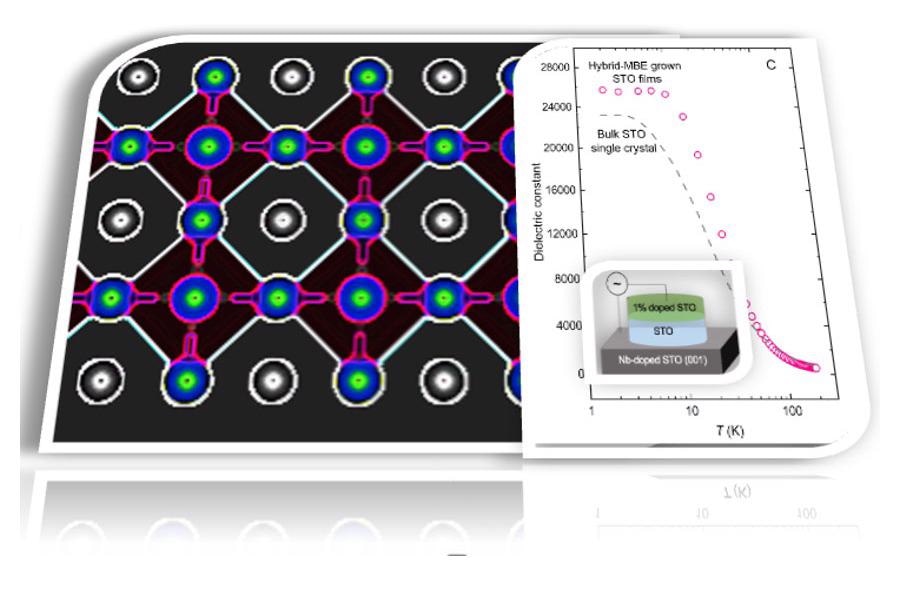A team of researchers led by the University of Minnesota Twin Cities has addressed a long-standing mystery regarding strontium titanate, an odd metal oxide that can function as an insulator, a semiconductor, or a metal. The study sheds light on how this material could be used in electronic gadgets and data storage in the coming years.
 University of Minnesota Associate Professor Bharat Jalan and his students discovered that the true dielectric constant of their strontium titanate films exceeds 25,000—the highest ever measured for this material. Image Credit: Jalan Group, University of Minnesota
University of Minnesota Associate Professor Bharat Jalan and his students discovered that the true dielectric constant of their strontium titanate films exceeds 25,000—the highest ever measured for this material. Image Credit: Jalan Group, University of Minnesota
The paper was reported in the significant Proceedings of the National Academy of Sciences of the United States of America (PNAS) scientific journal.
The electric field between the plates leads the negatively charged electrons and positive nuclei to match up in the field direction when an insulator such as strontium titanate is placed between oppositely charged metal plates.
Thermal vibrations prevent this regular lining up of electrons and nuclei, and the degree of control is quantified by a fundamental number called the dielectric constant. The dielectric constant is higher at low temperatures, where thermal vibrations are poor.
The dielectric constant is significant in semiconductors because it effectively “screens,” or protects, the conducting electrons from other charged flaws in the material. A large dielectric constant is essential for applications in electrical devices.
Strontium titanate samples of top-quality centimeter size have a calculated low-temperature dielectric constant of 22,000, which is quite high and promising for applications. However, thin films are required for the majority of applications in computers and other devices. Despite the efforts of many scientists who used a variety of ways to create thin films, only a dielectric constant of 100-1,000 has been attained in strontium titanate thin films.
The interface between the film and the substrate, or the film and the next layer up, can be critical in thin films that are only a few atomic layers thick.
Bharat Jalan, a senior author on the work and the Shell Chair in the Department of Chemical Engineering and Materials Science at the University of Minnesota, hypothesized that these “buried” surfaces could be hiding the true dielectric constant of strontium titanate. Jalan and his colleagues revealed that the real dielectric constant of their strontium titanate sheets reaches 25,000, which is the maximum value ever recorded for this material.
Even if both metal and the insulator are generated from the same material, the discoveries of Jalan, his students and collaborators provide essential insight into the importance of interfaces between an insulator and a metal as seen in capacitor architectures common in advanced technology.
Semiconductors are among the most important materials used in modern technology. While much is known about conventional semiconductors such as silicon and gallium arsenide, there are several unsolved mysteries surrounding oxide semiconductors like strontium titanate.
Bharat Jalan, Study Senior Author, University of Minnesota
According to Jalan, through flaw and interface management, they were able to tackle a long-standing problem with low dielectric constants in strontium titanate films.
These results build on a remarkable record of success for the method of film growth, known as hybrid Molecular Beam Epitaxy, discovered by Jalan. The quality of the films from Jalan’s group is truly exceptional.
Richard James, Study Co-Author and Distinguished McKnight University Professor, Aerospace Engineering and Mechanics, University of Minnesota
Zhifei Yang, a graduate student in the University of Minnesota’s School of Physics and Astronomy who is mentored by Jalan, led the measuring effort.
“It was quite rewarding to see that an interface only a few atomic layers thick can have a tremendous impact on the measured value,” Yang commented on the detection of high dielectric constants.
The research group also included Dooyong Lee and Jin Yue from the University of Minnesota Department of Chemical Engineering and Materials Science; Judith Gabel and Tien-Lin Lee from the Diamond Light Source in the United Kingdom; and Scott Chambers from the Pacific Northwest National Laboratory Physical and Computational Sciences Directorate.
The Air Force Office of Scientific Research (AFOSR), the National Science Foundation’s Materials Science and Engineering Research Center (MRSEC) program, the Vannevar Bush Faculty Fellowship, and the United States Department of Energy’s Office of Science, Division of Materials Sciences and Engineering all contributed to the study.
Journal Reference:
Yang, Z., et al. (2022) Epitaxial SrTiO3 films with dielectric constants exceeding 25,000. Proceedings of the National Academy of Sciences. doi.org/10.1073/pnas.2202189119.